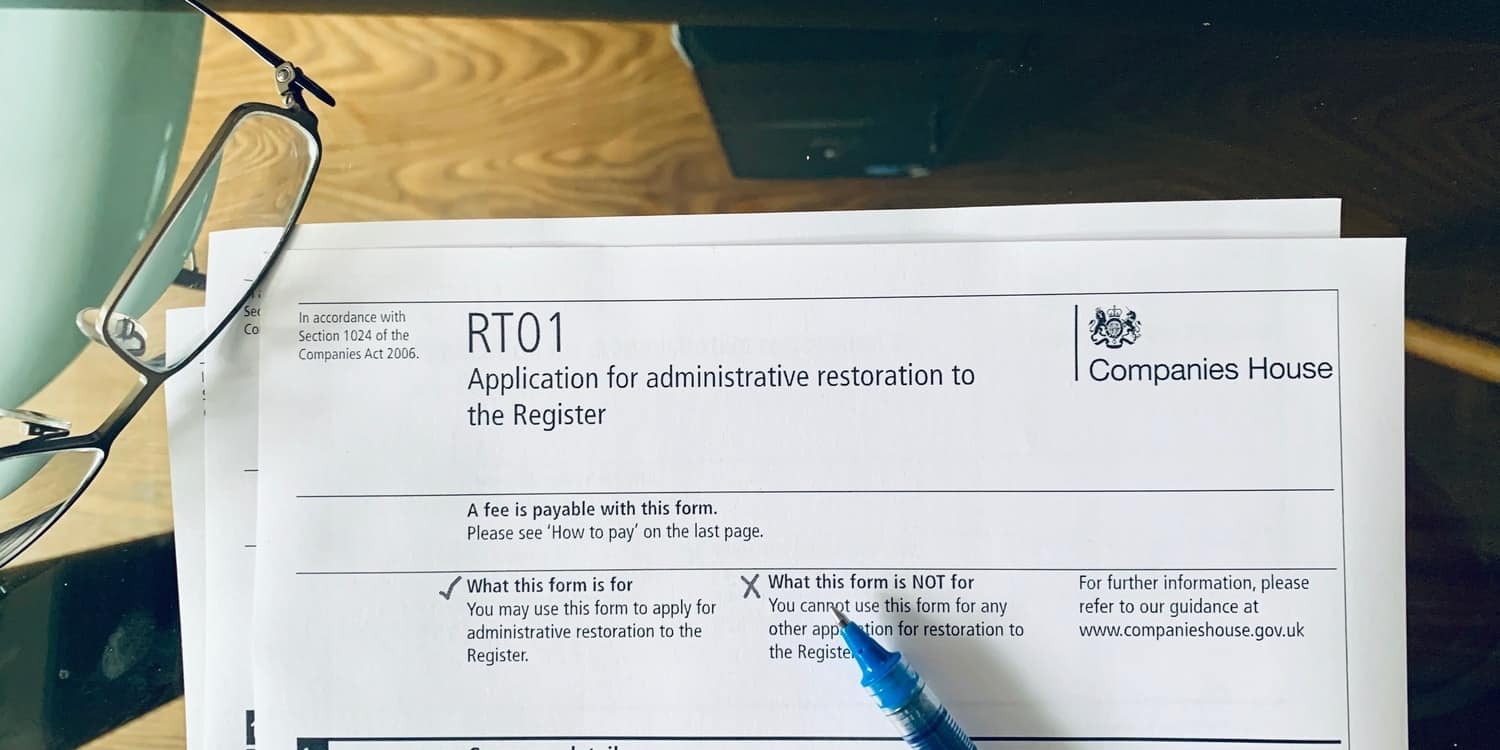If your company has been dissolved, there may be a time when you want to consider bringing the company back to life – this is known as restoration.
Whether you want to restore your company to get monies back, or because you want to start trading again, it will be important to understand the pros and cons, to help you decide if restoring your company is the right decision for you.
This guide to restoration will inform you of the processes involved and the criteria needed to go about reinstating a company.
Key takeaways
- Restoring a dissolved company can recover assets but may incur significant administrative costs and penalties.
- Administrative restoration is quicker but requires specific conditions; court restoration is more complex and time-consuming.
- Third parties owed money can also apply for restoration, enabling them to recover debts from the dissolved company.
When is it possible to restore a company?
When a company is dissolved, all of the company’s assets are passed to the Crown. This is known legally as ‘bona vacantia’ (Latin for ‘ownerless goods’). The assets in question include shares, property and land, mortgages, and intellectual property (such as trademarks and patents, etc.).
It is sometimes possible to restore a dissolved company to continue trading or to claim assets and monies owed. To do so, the following conditions need to be applicable to the company:
- the company was trading or operating at the time of being dissolved
- the company was struck off by the Registrar (under sections 1000 or 1001 of the Companies Act 2006)
- your application to restore the company must be made within 6 years of the company being dissolved
If the above conditions do not apply, or if the company was dissolved voluntarily (and a company director filed form DS01), it will not be possible to apply for administrative restoration. In these circumstances, the company’s directors and shareholders, and even third parties (such as creditors), may be able to proceed with restoration via a Court Order. We’ll look at this in more depth later on in the article.
Why would you want to restore a company?
The most common reason for wanting to restore a company is because former directors or shareholders want to retrieve bona vacantia assets that were accidentally left in the company when it dissolved, and which have not yet been disposed of. Another common reason is they may simply wish to recommence trading.
For third parties, restoration is a way of ensuring that debts are paid, i.e. if a creditor has outstanding debts at the time the company was dissolved, it might be possible for them to see the debts repaid if it is restored. There are various factors to consider before making the decision to restore a company. Some of the pros and cons include:
Pros
- You can retrieve assets that are held by the Crown (which have not been disposed of).
- You can begin trading again with the same entity (including company registration number).
- You will again be able to enjoy the benefits that companies usually bring including limited liability of the shareholders, a separate legal personality (ability to enter into contracts), etc.
Cons
- If there were any outstanding penalties for late filing of company accounts, before your company was dissolved, these will become due. This does not include the period during which the company was dissolved.
- All other filings that would have been due, had the company had an uninterrupted existence, need be prepared and filed.
- There are unavoidable administrative costs involved in the process of bringing a dissolved company back to life, regardless of which route you take. These are discussed later.
- It is possible the name of your company, or a very similar one, has been taken by another organisation since the time your company was dissolved. This will mean that you are unable to reinstate the original name – resulting in more time spent in deciding and marketing a new unique name.
What is the procedure for restoring a company?
There are two main routes for undertaking the restoration of a company, namely administrative restoration and court restoration. The process you choose will depend on how the company was dissolved in the first place.
Administrative Restoration
An administrative restoration is an application made to Companies House to bring the company back into existence. It can be made by either a former director or shareholder, for which the following is required:
- RT01 Form – Application for administrative restoration to the This includes the company name and the associated company registration number.
- Any paperwork that was due (or late) at the time the company was dissolved, such as annual accounts and confirmation statement. Any late filing penalties will also be due.
- A fee of £100. Cheques are made payable to Companies House. You should write the company name and registration number on the back.
- A bona vacantia waiver letter (if the company had assets it needs to retrieve). This is obtained from the Government Legal Department, unless your company was registered in Lancashire, Cornwall, Greater Manchester, Merseyside, Stockport, Cheshire, and Cumbria, the bona vacantia letter needs to come from the Duchies of Cornwall or Lancaster’s Solicitors, Messrs Farrer & Co.
In some circumstances, an alternative company name is included on the paperwork. This is in cases where the name has since been registered to a different company.
Once the paperwork is complete and fee has been sent to Companies House, the decision to restore should be finalised within two weeks. If successful, Companies House will approve your application and will restore the company on the register.
This will then be visible on the register, and a notice of restoration will also be included in the Gazette. However, the original striking off of the company will also remain on the Companies House website.
If Companies House rejects your application to restore your company, you will need to know why this was the case. If your application was rejected simply because you failed to include all the necessary documentation, you can resubmit any missing information.
If the rejection wasn’t due to an administrative error there are two further routes to explore: getting a Court Order or a discretionary grant.
Court Order
Section 1029 of the Companies Act 2006 allows for a Court Order to restore a company where administrative restoration is not possible. The process is longer and more complex than that of an administrative restoration, so you are recommended to seek professional advice if you are thinking of going down this route.
The procedure for a court restoration begins with the completion of a Claim form and Witness Statement, the latter of which sets out basic details about the company such as the address it was registered at, who the directors were, why the company was struck off, and why the restoration is sought.
The Claim form and Witness Statement should then be submitted to the court – this can be either the Central London County Court or select District courts. A £280 Court fee is also payable.
The Court will in turn issue the Claim form, returning it to the applicant. Copies of this issued Claim form and the signed Witness Statement should then be delivered to the Registrar of Companies and Government Legal Department (formerly the Treasury Solicitor).
If the company was incorporated in Lancashire, Cornwall, Greater Manchester, Merseyside, Stockport, Cheshire, and Cumbrian, then the Claim form and Witness Statement should also be served on Messrs Farrer & Co, who are the Solicitors to the Duchy of Lancaster and Duke of Cornwall.
The Government Legal Department will then set out the requirements for the company to be restored. What those requirements are will depend on the reasons for restoring the company. If the company is being restored to begin trading again, all filings the company would have had to make, had it enjoyed an uninterrupted life – will have to be completed.
These filings include all confirmation statements and annual accounts due. They should all be delivered to Companies House together with any late filing penalties that are payable. Confirmation of this having been carried out should be sent to the Government Legal Department.
On the other hand, if the company is being restored only to retrieve assets that were left in it when it was struck off, then the company would be asked to provide an undertaking. An undertaking is essentially a ‘promise’ that’s made to the court, that the company will be struck off again after the assets are retrieved. A letter will need to be delivered to the Government confirming that the required undertakings will be given to the court.
At this point it will also be necessary to pay the Companies House fee for restoring the company, which is approximately £300. This payment should be made to the Government Legal Department, and not directly to Companies House.
Once completed, another Witness Statement should then be submitted to the Court to confirm that the required documents have been served to the respective parties, with confirmation that there are no objections to the restoration of the company. The Government Legal Department will then send you a draft Order, together with an undertaking if also necessary. The document(s) should be signed and then dispatched to the Court who will seal them for you.
Once you receive the sealed Order, the final stage is to forward it to Companies House. This concludes the process, and the company is finally restored. It will now be possible to carry out the things you originally set out to achieve – be it to retrieve the assets from the company or to recommence trading.
It is also possible for third parties who are owed money by the company to apply for the restoration of a company. These include those who:
- did business with the company
- are owed money at the time the company was dissolved
- have a competing or shared interest in land
- worked for the company
- were a shareholder or director when the company was dissolved
- are responsible for the pension fund for the company’s employees
Successful restoration applications from these parties will mean the company is restored and they shall be able to:
- get a ‘judgment’ from court for the amount of the money owed, with interest and costs
- issue a statutory demand
- apply to ‘wind up’ the company (referred to as compulsory liquidation) – this is when a company cannot afford to pay its debts. In this case, you need to be owed £750 or more, and be able to prove that the company cannot pay you.
Discretionary Grant
The Bona Vacantia division of the Government Legal Department may, in some instances, allow for a ‘discretionary grant’. Separate to a Court Order, this method is open to former shareholders, former liquidators, former administrators, and former company voluntary arrangement supervisors who wish to recover assets. It is not available to former directors.
A discretionary grant is a sum of money that can be paid by Bona Vacantia division where a company restoration is not possible, or as a means of avoiding the sometimes complex and expensive Court method (although, in the latter case, the maximum grant is limited to just £3,000).
To apply for a discretionary grant in England and Wales (except Lancashire, Cornwall, Greater Manchester, Merseyside, Stockport, Cheshire, and Cumbria) you must contact the Government Legal Department. The Government Legal Department can provide guidance on what you should do – this will be dependent on whether the company can be restored.
If your company was based in one of the other jurisdictions, contact details for your respective applications are: Lancashire, Cornwall, Greater Manchester, Merseyside, Stockport, Cheshire, and Cumbria: Farrer and Co. Scotland: The Queen’s and Lord Treasurer’s Remembrancer. Northern Ireland: the Crown Solicitor’s Office for Northern Ireland.
Don’t rush to restore
The process of restoration is often long, expensive and time consuming. We recommend that you weigh up the pros and cons before proceeding, especially considering that not all applications are successful. The opportunity to form a new company can often be a more appealing option, especially if your aim is to trade again, rather than to recover debts. If you are unsure, we always suggest seeking professional advice.
Need help to restore a dissolved company?
Quality Company Formations have an experienced Company Secretarial Team who are available to carry out company restoration work. Please give them a call at 020 3984 5389 or email [email protected], for an introductory discussion and/or quotation.














Join The Discussion
Comments (2)
If a company is restored – not by a director or shareholder but by an injury claim solicitor 22 years after it was voluntarily dissolved (assets were sold and liabilities settled prior to being dissolved, the company was solvent at the time it ceased trading – the injury claim was dealt with by the employment insurer from when the company was still active but couldn’t pay the compensation to the former employee with the company dissolved).
Could the director still resume trading with the company or is this a different situation from being restored by a director or shareholder?
Thank you for your kind enquiry, Michael.
In general terms, a voluntary dissolution so would require a court restoration. In most cases, the application for restoration must be made within 6 years of the date of dissolution of the company, except in the case of a personal injury claim. When bringing the personal injury claim, a claim for restoration of the company can be made at any time.
We trust this information is of use to you.
Kind regards,
The QCF Team